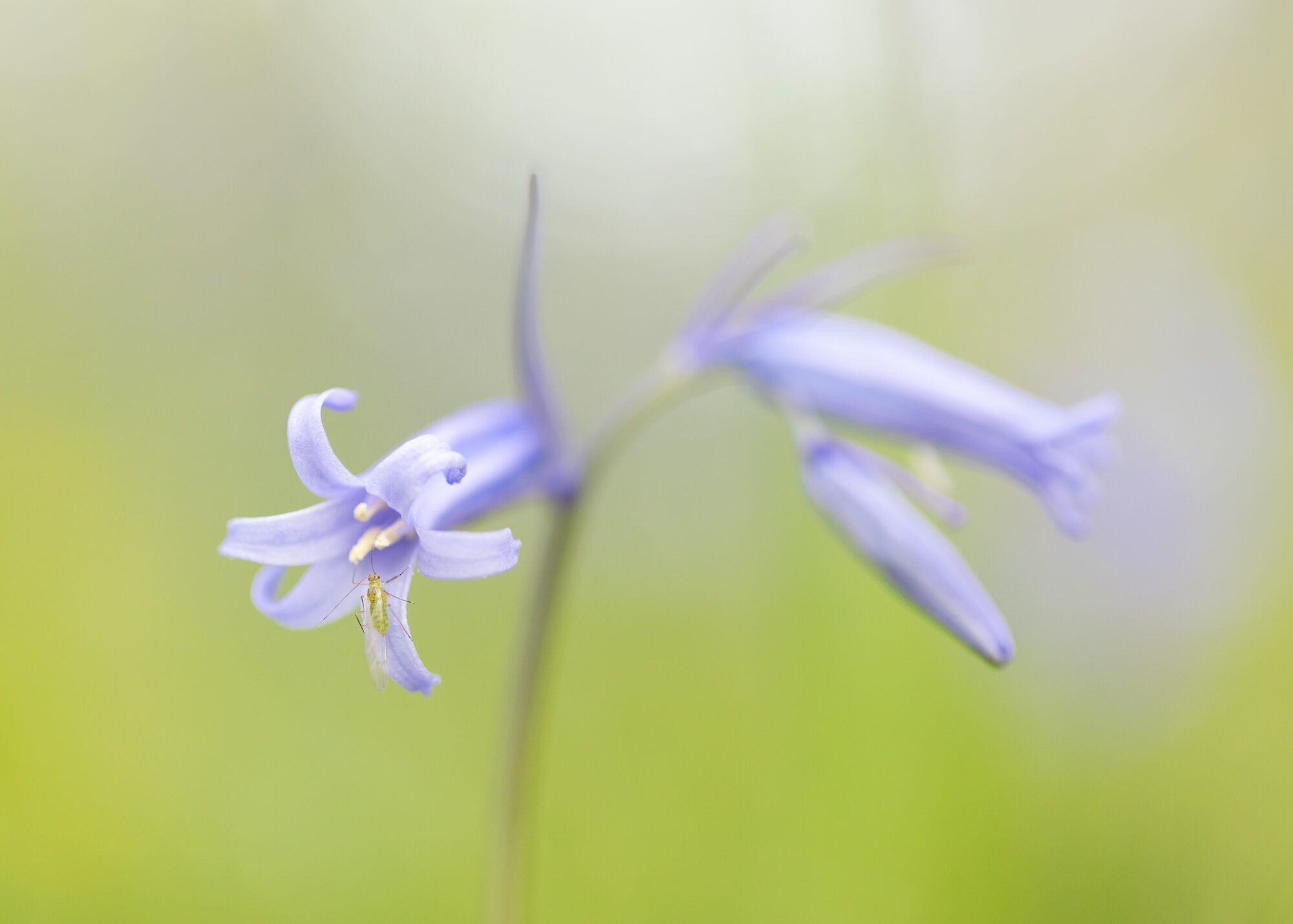Nature and landscape photography, every day of the month, throughout May. That was my plan, plain and simple.
From a photography viewpoint, spring is regarded as one of the most photogenic seasons of the year, and for good reason. Spring is synonymous with new life and natural beauty, but don’t blink, or you’ll miss it. Change occurs quickly, extraordinarily quickly. At the peak of spring, wildflowers enter the battle of their lives, each competing for space and light. Insects pollinate the beautiful wildflowers, paving the way for future generations. Trees burst into life, expanding their canopies and offering protection to birds and mammals seeking refuge. No two days are ever the same, and that’s what makes spring so appealing to photographers.
To make the most of this intimate time of year, I came up with a plan. A plan to spend more time in the great outdoors and photograph the natural beauty I found along the way. 31 days of spring photography. Me, my camera, and the great outdoors during one of the most photogenic times of the year. What’s not to like?
The Loss of My Hero and Number One Fan
As my challenge began, my family and I were blindsided by the heartbreaking loss of my Dad. Words can’t express how much losing your hero hurts. I almost threw in the towel. The only thing that kept me going was the fact that my Dad loved to see my photographs. He was forever telling me to submit them to Countryfile, which I always shrugged off. Truth be told, I never thought they were good enough.
Instead of beating myself up, I found a new motivation. To keep pushing forward and make my Dad proud. The best way I could honour this was to continue the very thing he loved to see me do, photography. So, Dad, this one is for you!
Outlining a Plan to Keep Me Focused
If you are anything like me, you produce your best work when you are working towards something. Clearly defined goals help keep me focused. There’s nothing I love more than escaping into the great outdoors with my camera, but I wanted to make sure that the project was productive. It was the perfect opportunity to develop my knowledge and skillset, adding value to the project as a whole. With that said, I came up with a small list of objectives:
- To capture emotive photographs
- To be more observant and patient in dynamic environments
- To make the most of seasonal subjects
- To explore all photographic avenues: macro, wide-angle and telephoto
Kick-starting a Month of Spring Photography in the Lake District
Landscape Photography in the Central Lake District
Where better to kick-start a month of spring photography than the Lake District, right? On the 1st of May, I headed to a location I hadn’t been to for quite some time, Loughrigg Fell. This breathtaking little fell is located within the central fells and stands at a relatively low height of 335m. Don’t let its height fool you. For such a small fell, Loughrigg Fell packs a serious punch in terms of panoramic views. It’s typically more of an autumnal location for me, but on this particular morning, it was the perfect location to make the most of the potential temperature inversion.
What a morning it turned out to be. Carpets of fluffy mist ebbed and flowed through the surrounding valleys. As the sun began to rise, the Langdales and beyond were the first fells to bathe in the gorgeous golden light, the sun gently illuminating the tops of the fells. This provided the focal point for my first landscape photograph, a spectacular view towards Langdale Valley. The frame was filled with beautiful elements of sunrise coupled with a generous helping of mist. What a view, one I will never tire of.
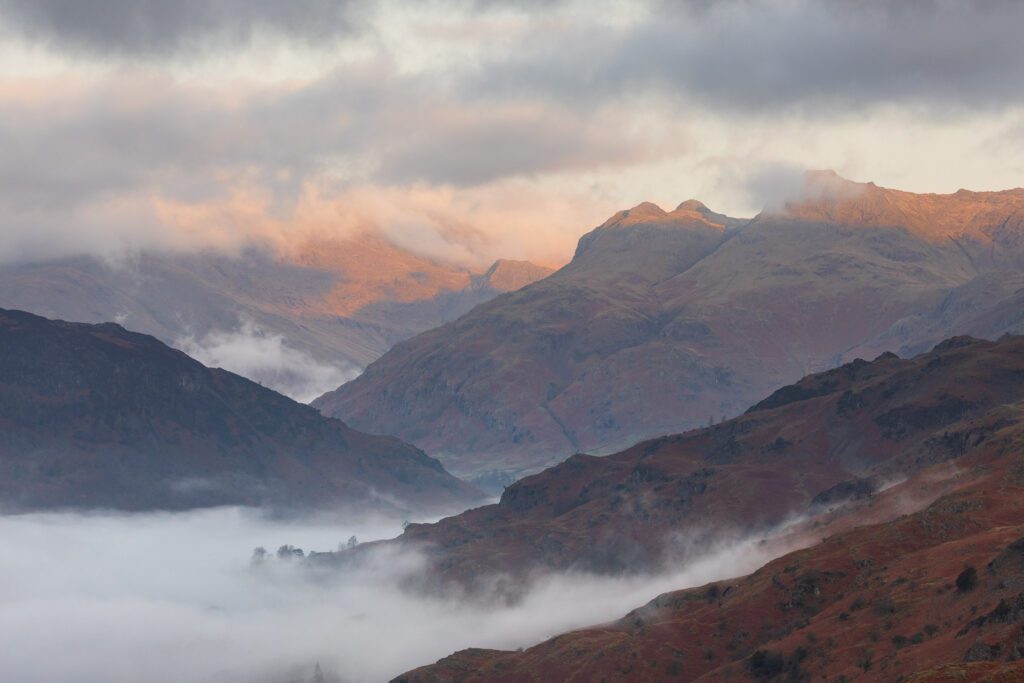
For my second photograph of the morning, I knew exactly what I had in mind. You can’t make the most of a temperature inversion without photographing isolated trees. Beautiful clusters of trees and mist, it’s a match made in heaven. Unfortunately, this time around, the mist was a little stubborn and decided to linger slightly higher than I would have liked. It wasn’t a huge problem, but it did mean that the trees were less able to reveal themselves amongst the mist.
After scouring the area for the perfect cluster, I eventually settled on a beautiful group of Larch trees. The trees were just about prominent enough to stand out amongst the mist. By this point, there was no light to be had; the sun had been blocked by a rather large bank of clouds not long after sunset. Still, what a way to end the first day of my spring photography adventure.
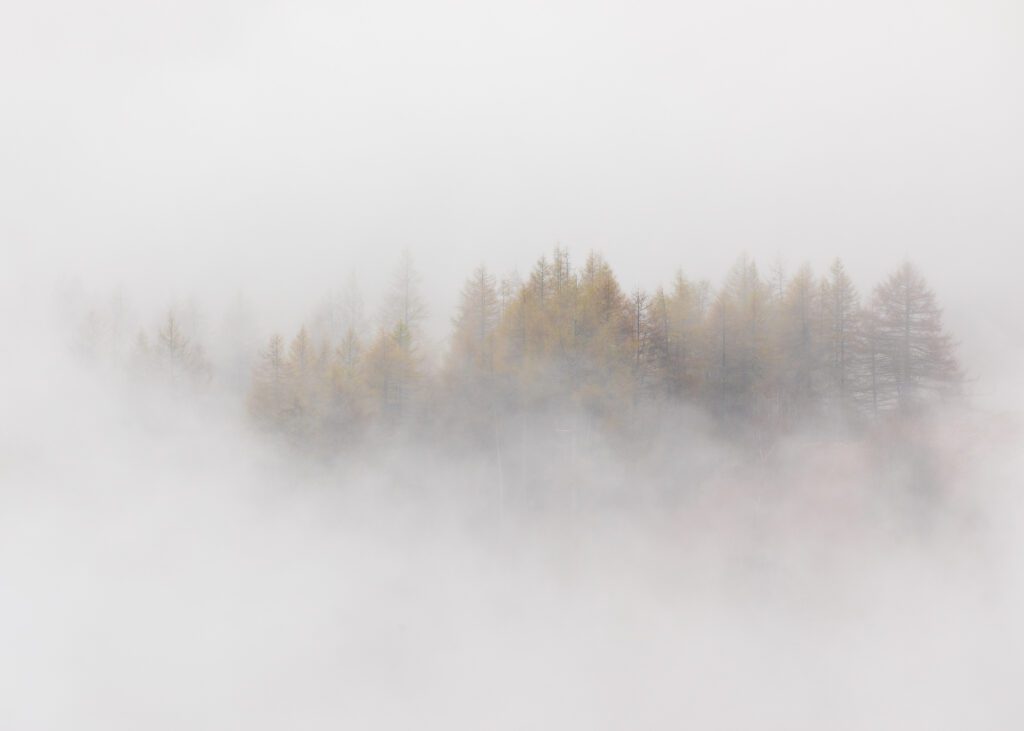
Local Woodland Provides Spring Photography Surprises
In the following days, my world was turned upside down. The loss of my dad caught us all off guard. To stop my mind wandering, I pushed myself to continue my spring photography project. I knew full well that my dad wouldn’t have wanted me to stop. Out of respect and to remain close to family, I decided to stay local for the remainder of the month.
All photographs illustrated from here on were captured within a 2-mile radius of my house. I must admit, I didn’t expect such a variety of subjects. There was a bit of everything, from gorgeous landscapes to a wide range of wildlife, which I captured with a mix of macro and telephoto focal lengths.
Capturing Elements of Spring in a Local Woodland
As the first week of May drew to a close, I made a beeline for my local woodland. I’ve spent so much time in there this year, making the most of the phenomenal Bluebell and Wild Garlic season. This year, in particular, has been by far one of the best displays I have ever seen – a far cry from last year’s washout spring.
This time around, I wanted to capture the last of the Bluebells more intimately. It wasn’t long before I found exactly what I was looking for. It was perfect, and a nice little addition to the flower, aptly summed up this year’s spring – see if you can see what I’m talking about.
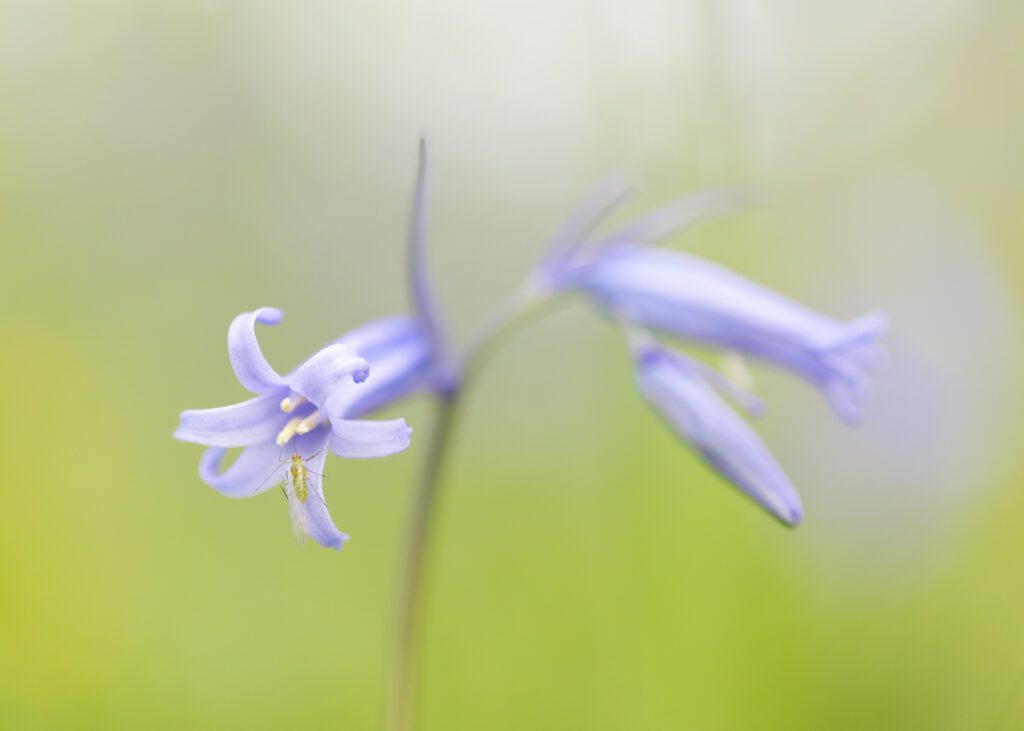
That’s right, the little Greenfly! It seemed fitting that this little guy was a feature within this photograph, given the significant population of them this year. I don’t think I’ve ever seen a spring quite like it. Some people don’t like them, but I don’t mind them at all. In a way, they’re the plankton of the land. A strong year for Greenflies works its way up the food chain, meaning in theory, it should be a great year for wildlife.
An Unexpected Encounter With a Family of Six
You’re probably reading this thinking, what? Let me explain.
It was another evening spent exploring my local woodland. By this point, the canopy was becoming more and more dense by the day. Eventually, it reached the point where the late afternoon light was struggling to find a clear path through. I was walking along a brook which runs through the woodland when I noticed movement in the shallow water up ahead. Carefully, I crept closer, taking cover behind a dense cluster of Wild Garlic (which smelled unbelievable by the way). About 15 metres or so in front of me, a family of six ducklings were enjoying a spot of lunch, closely supervised by Mum. In the heat of the late evening, a large swarm of flies were buzzing around just above the surface of the water. To the ducklings, it was an all-you-can-eat buffet. I’d never seen anything like it.
After a few minutes of not believing what I was seeing, I slowly and silently pulled out my camera fitted with my 70-200mm lens. Never in my life have I been more disappointed with my choice to leave my 100-400mm lens at home, it’s always the way, isn’t it! However, I had to make do with what I had. Needless to say, I sat at the 200mm focal length and picked a spot of the brook that was still illuminated with the little light that was able to penetrate the woodland. The waiting game began. I was waiting for the perfect opportunity to capture this behaviour at its best, and here’s what I came up with. All things considered, I couldn’t have been happier with the results.
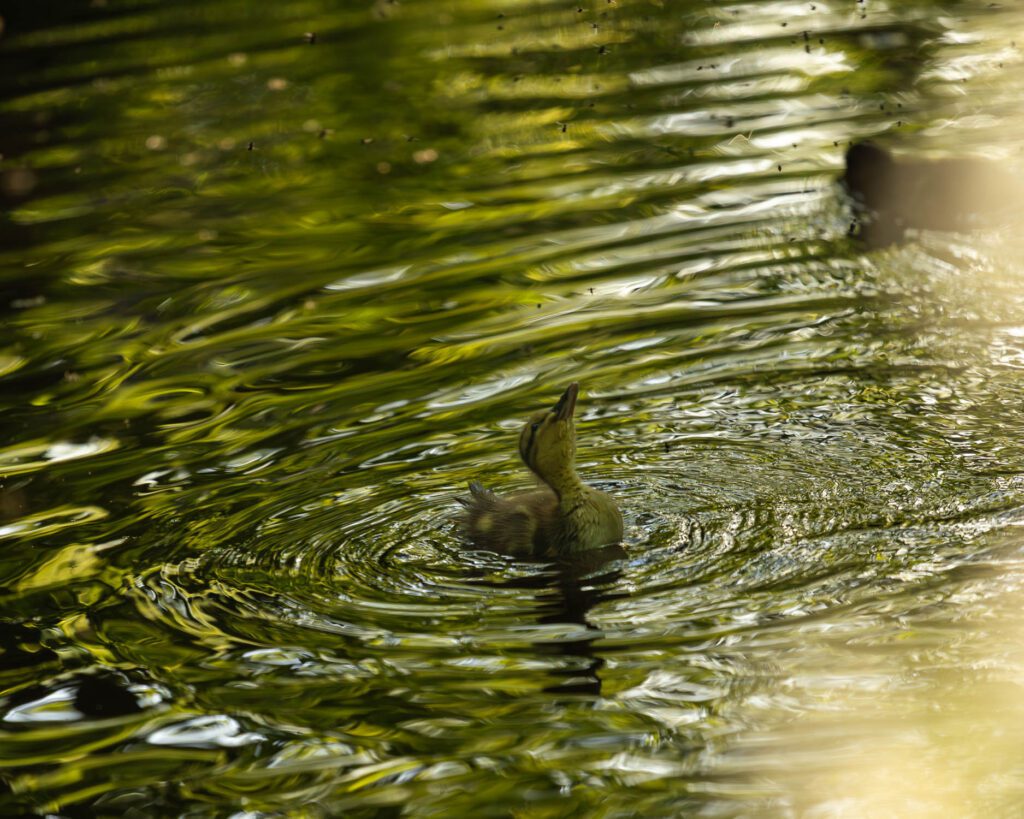
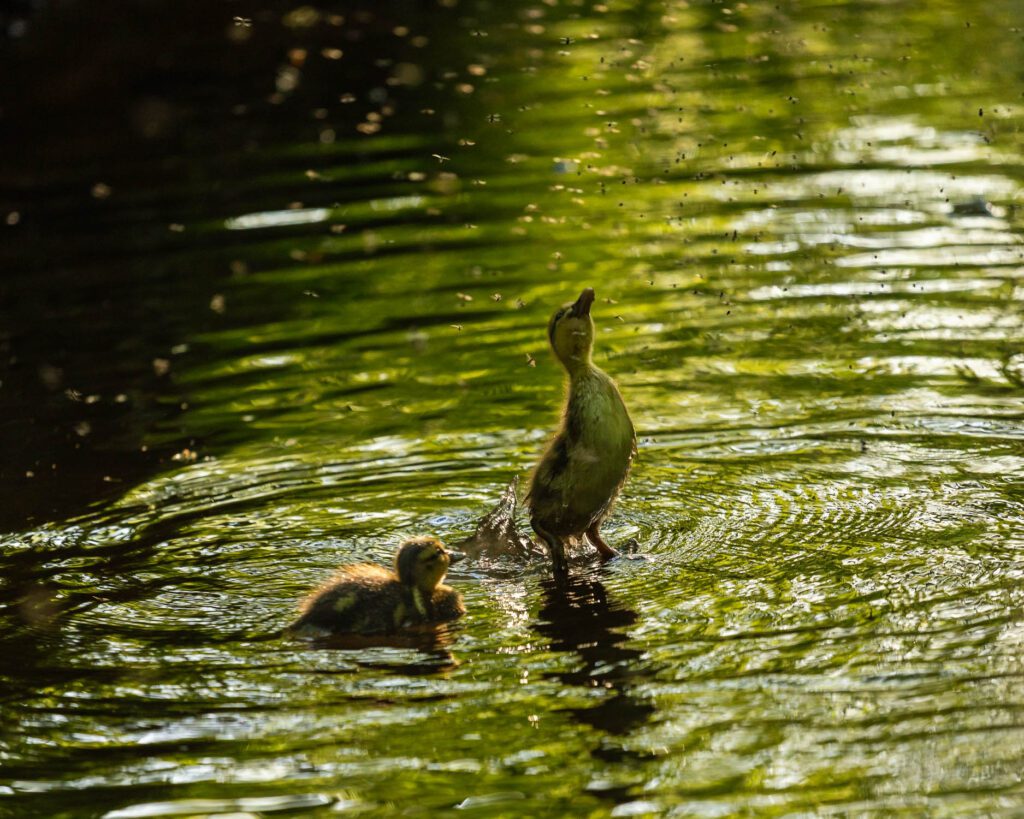
In the first photograph, one of the ducklings has his eye firmly on the prize, a cluster of flies – soon to be lunch. In the second photograph, with a powerful lunge, he leaps from the water, propelling himself towards his target. Witnessing this was by far one of the best hours I’d ever spent in the woodland, and it left me hungry for more.
Another Unexpected Encounter With a Surprised Local
Over the next few days, I returned to the woodland. This time I was armed with my 100-400mm lens, hoping for another opportunity to photograph the beautiful ducklings. I had no luck whatsoever. That was until one evening when I heard a very familiar call. A call I hear often throughout the night, but very rarely have the pleasure of seeing the source. It was, of course, the call of a Tawny owl. It sounded close, very close. I scoured the surrounding trees around me until my heart jumped. There she was, in all of her glory and perched directly above me. I had no idea she was there, but she knew exactly where I was. No doubt she had her eyes locked on me from the moment I arrived.
Tentatively, I slowly raised my camera and swiftly adjusted settings to cater to the complex scene, before taking a few photographs. Happy with what I had and not wanting to overstay my welcome, I slowly backed off and left her in peace.

Captured at 400mm with image stabilisation, I was able to get a decently sharp image with ISO 1600 and a shutter speed of 1/250th at F5.6 with spot metering. Tawny owls are one of my all-time favourite birds of prey; they are truly iconic. Tawnies are masters of camouflage, and that’s what makes this photograph so special to me; they’re typically heard and not seen. Dad, you would have been made up with this one.
Late Spring Landscape Photography – Countryside Scenes
Given my success in the woodland, I thought it was time to explore more of the beautiful countryside landscape. Luckily for me, less than 100m from the woodland lies a public pathway through the breathtaking countryside. I’ve walked this route countless times, and I’ve always admired a lone Hawthorn tree which stands next to a sheep enclosure. Up until recently, I’d never attempted to photograph it. On this particular mid-May evening, however, that all changed.
The evening gave birth to one of the most breathtaking sunsets of the year so far. It was one of those sunsets which made everything look photogenic. Vibrant, with enough cloud and contrast to create depth from every angle. I lined up a composition and used the quintessential countryside wooden fencing as a lead to the gorgeous Hawthorn tree, which was in full bloom. The spectacular lighting did the rest of the work for me. All in all, a perfect balance of light and shadow to lead you through this beautiful late-spring countryside scene.
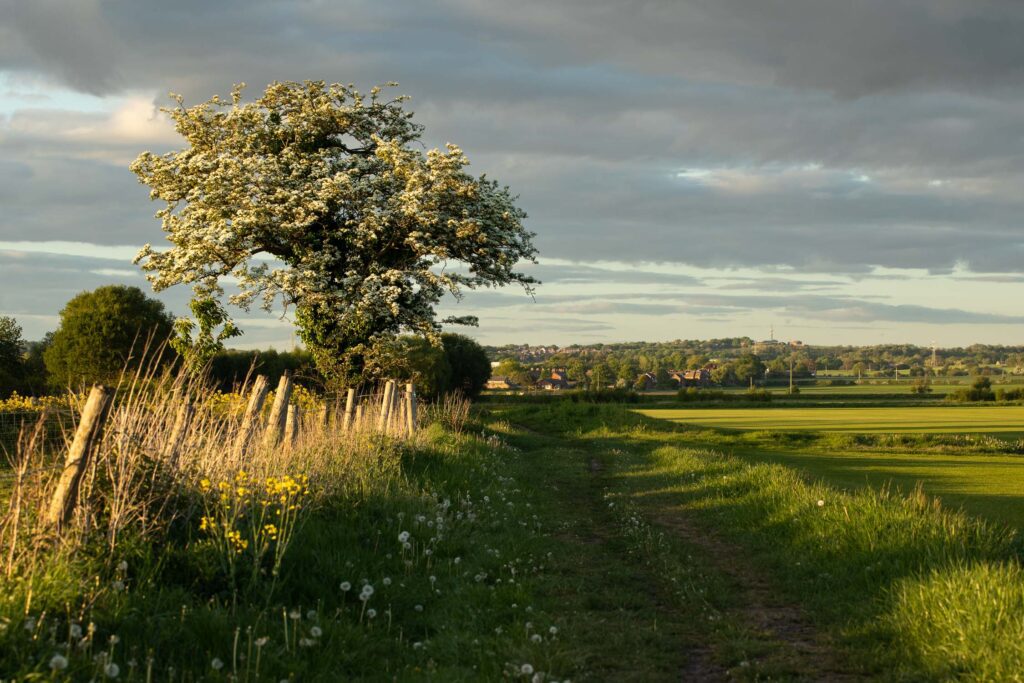
A Change of Perspective
After the success of the previous evening, I decided to return to the lone Hawthorn tree to consider a different perspective. There was no epic sunset to be had, but the sky was beautifully blue. I experimented with a few different angles before settling on a firm favourite. A gorgeous countryside scene framed by the perfection of the flowering Hawthorn, not a cloud in the sky. Not a bad view at all.
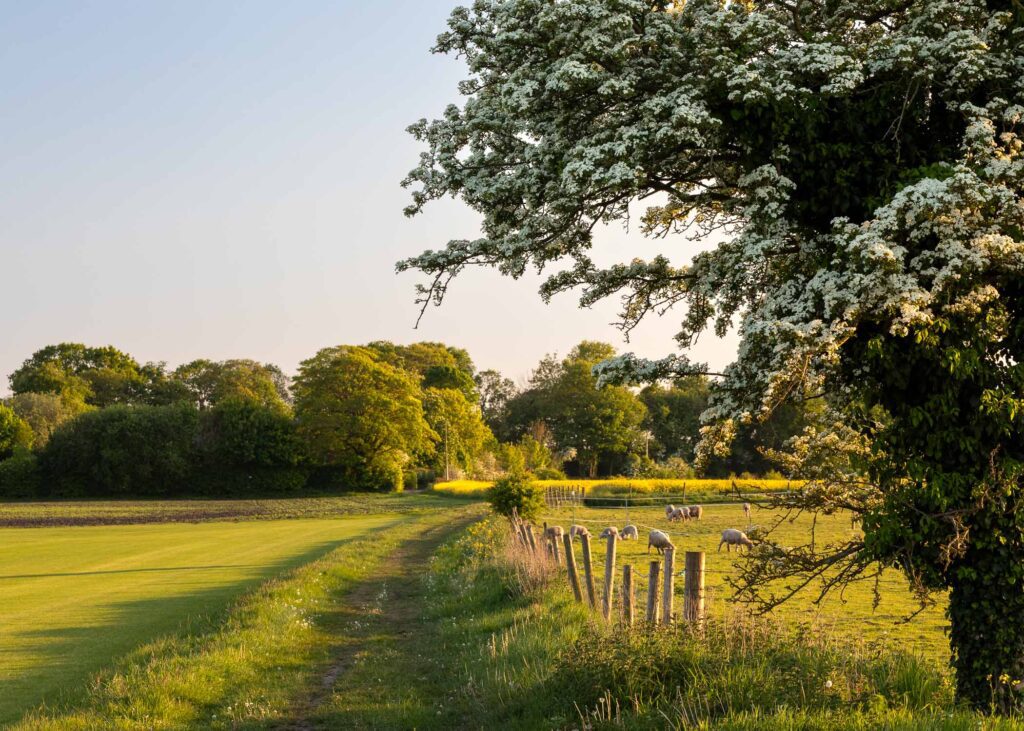
After capturing the photograph above, I decided to start heading home. That was until another lone tree caught my eye. The keen-eyed viewers out there may have noticed the field of yellow rapeseed in the background. Well, this lone Oak tree stood majestically in the middle of the field, surrounded by a sea of yellow. What’s more, the progressively lowering sun was delicately highlighting the right side of the trunk, a lovely detail adding contrast to the scene. I crouched down fairly low and used some foreground rapeseed as bokeh to frame the beautiful Oak.

Once again, extremely happy with the evening’s photographs, I headed home…and made it all of 10 metres. This time, I was stopped in my tracks by a group of lambs playing King of the Hill on a couple of old hay bales. It was truly heartwarming to witness. I wanted to capture them in action as best as I could. Unfortunately, by this point, the sun had set, and the light was quickly fading. I adjusted my settings to cater to the declining light (basically pushing my ISO as high as I was willing to take it) and waited for the perfect opportunity.
The moment arrived when two of the lambs affectionately put their heads together. What a moment to witness!
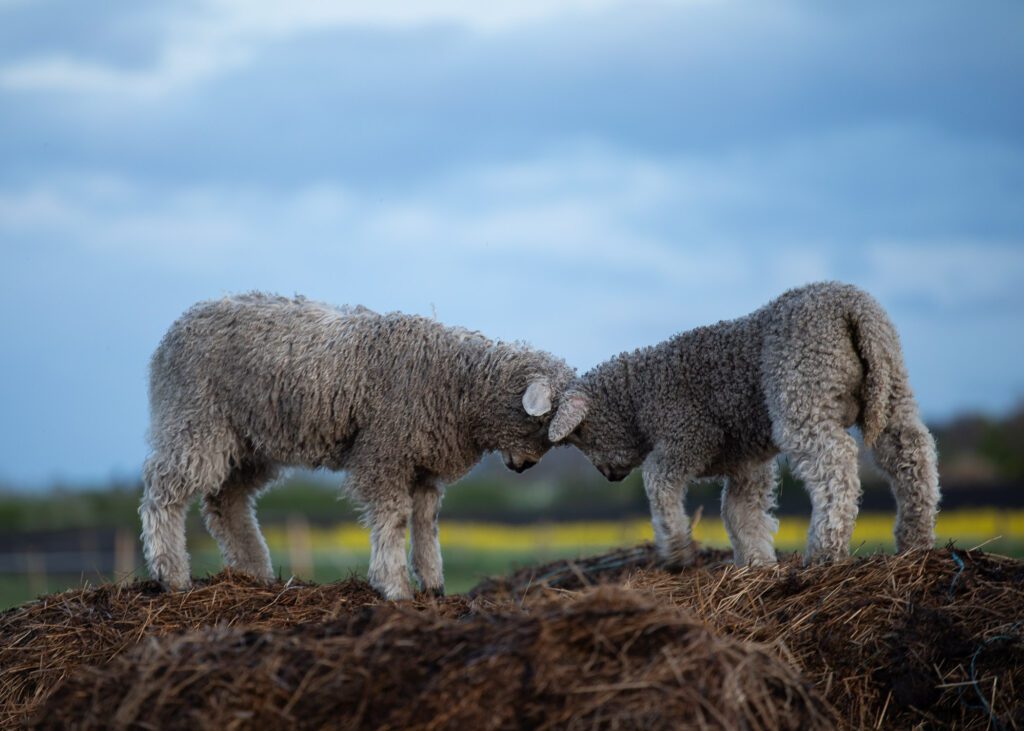
After capturing the above photograph, you’ll be glad to know that this time, I made it back home without stopping again.
An Unbelievable Spring for Macro Photography
Unsurprisingly, May turned out to be a record-breaking month in terms of average temperature and number of sunlight hours. Thanks to this, wildlife thrived, especially insect populations. With no shortage of subjects, it was time for a bit of macro photography.
Macro is one of my favourite genres of wildlife photography. It challenges you to think more proactively about your camera settings, especially depth of field. The closer you are to your subject, the narrower your depth of field. You increase your aperture, and light becomes an issue. Reduced light also means a slower shutter speed. It’s a delicate balancing act, all whilst your subject is prone to move at any time. Master macro photography and the skills you pick up along the way will transfer to all other genres.
A Macro Photography Favourite, the Downy Jumping Spider
Not everyone likes spiders, but one firm favourite within the macro photography community is the jumping spider species. For the most part, they’re tiny (especially the native UK species), but unbelievably cute. They have such good personalities and gestures, which make them a pleasure to photograph. Don’t be fooled into thinking they’re easy to photograph, though. Being small and insanely quick makes them a real challenge, but a rewarding one at that.
I remember a time when I used to see Zebra jumping spiders all the time throughout the summer months. But, ever since I found a love for macro photography, they’re nowhere to be seen! Luckily for me, towards the end of May, I stumbled across a couple of beautiful Downy jumping spiders, and they were more than willing to pose for a few photographs. Here’s what I managed to capture using my 100mm macro lens combined with the Raynox DCR-250.
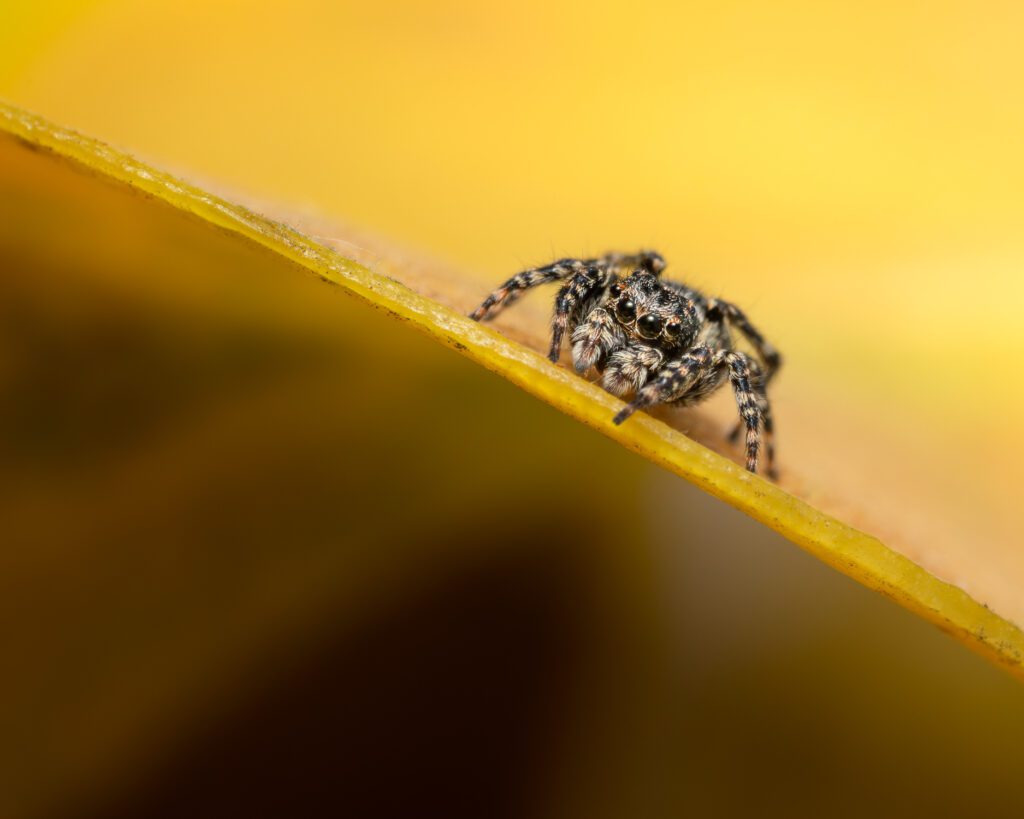
It’s worth bearing in mind that these beautiful creatures are about 5mm in size. Unless you’re out looking for them, you’ll likely never even notice they’re there.
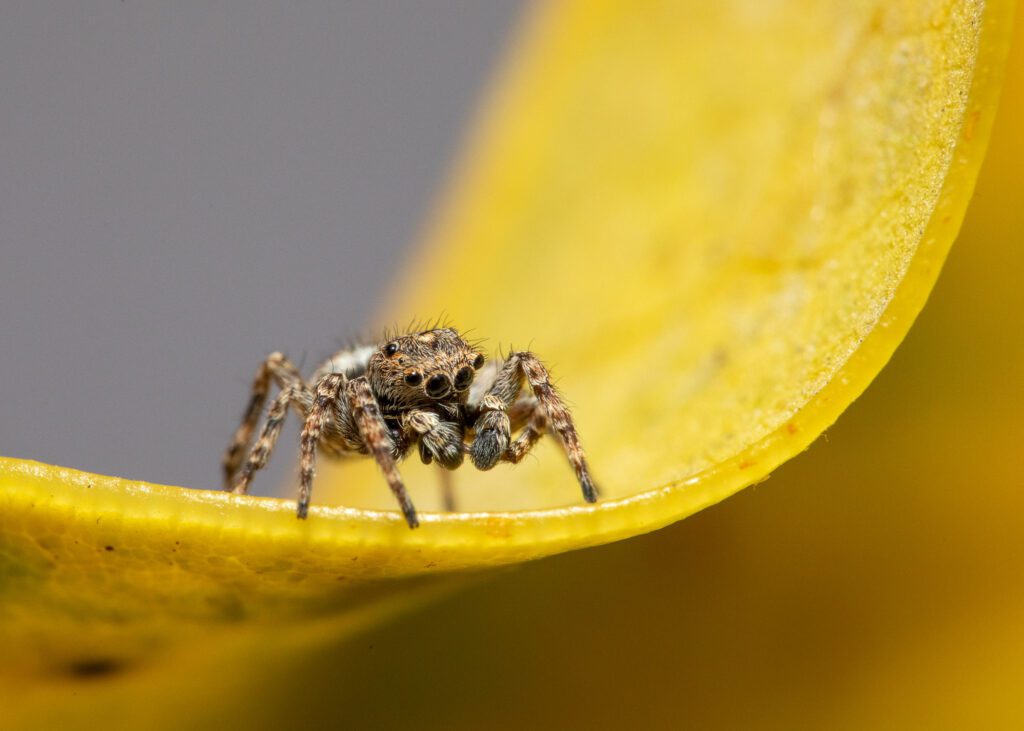
An Abundance of Damselflies, Macro Photography Heaven
After the success of photographing the Downy jumping spider, I thought I’d return to my local nature reserve to check out the wildlife around the pond. This turned out to be a fantastic idea. The damselflies were out in full force. It’s the perfect environment for damselflies and dragonflies. Surrounded by gorgeous yellow irises and beautiful water lilies, it’s easy to see why these amazing insects call it home.
At first glance, I spotted four different species darting around the pond. Armed with my 100mm macro lens, I was ready to capture them in action. It’s fairly easy to capture portraits of damselflies, as long as you don’t make any sudden movements, they’re pretty relaxed insects. However, I wanted more than just a portrait; I was hoping to capture their behaviour and tenacity. After three days of return trips, I managed to capture a handful of photographs that checked these boxes.
Hunting the Hunter
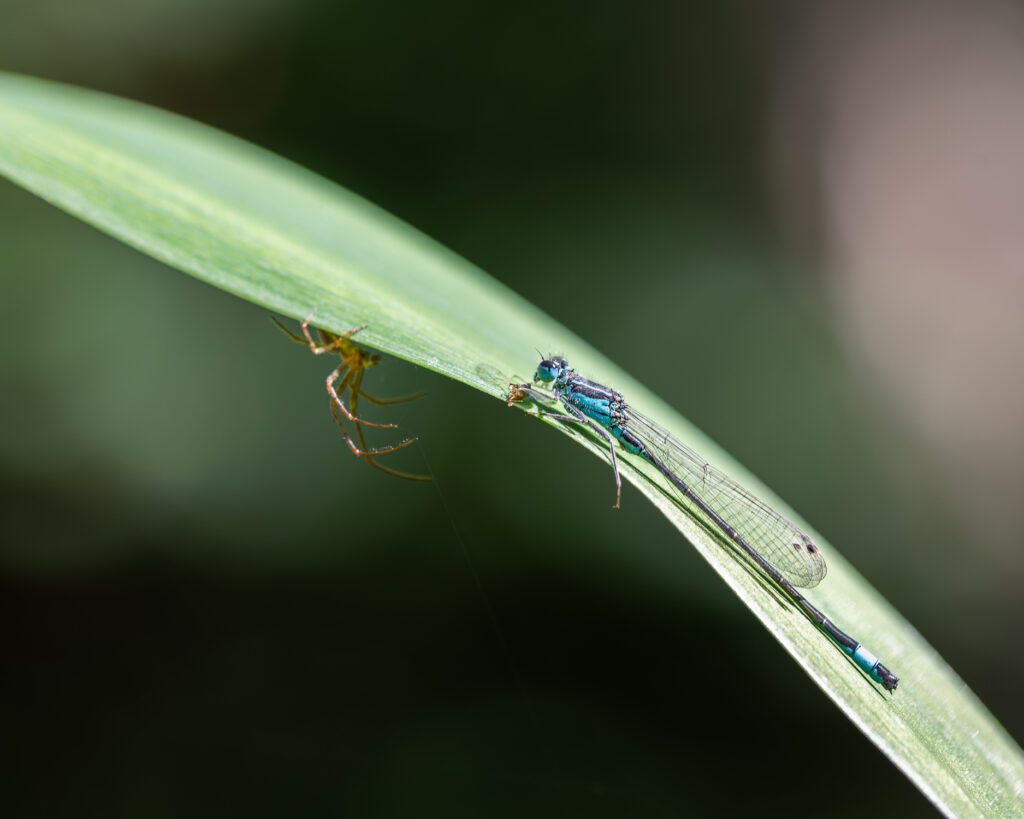
In this first photograph, I noticed that this Azure Blue damselfly had successfully captured a fly and landed on the leaf of a yellow iris to feast. I moved in slowly to capture the action, and as I did so, I noticed something unbelievable. Out of the corner of my eye, I saw a spider lurking in the shadows on the underside of the leaf. It was creeping closer and closer to the damselfly to the point I thought the hunter was going to become the hunted. In hindsight, I think the spider was attracted to the damselfly’s prey, which was, at the time, overhanging the leaf. Even still, it was a dramatic moment I was happy to have captured on camera. For anyone wondering, the Azure Blue did notice the incoming danger and flew away to another perch.
The Gymnast
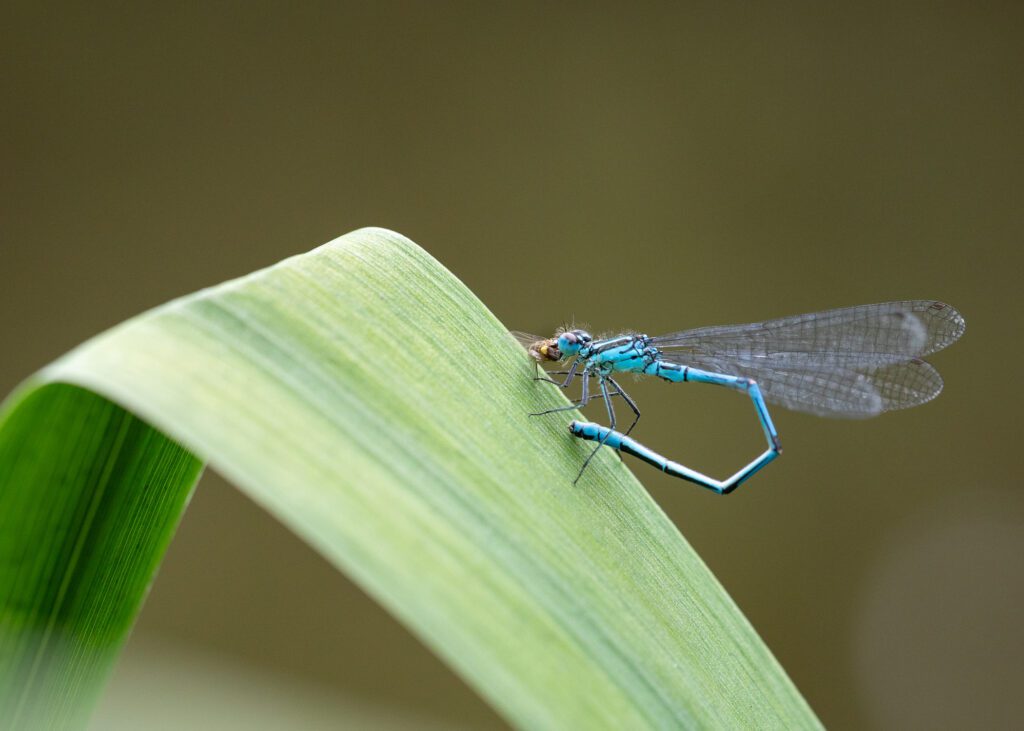
This next photograph features another Azure Blue damselfly. After a successful capture, the Azure Blue returned to its perch to enjoy its meal. It must have been excited to eat because as it returned to its territory, it started to break out the gymnastics moves. It’s mindblowing how flexible these amazing insects are. What’s equally as mindblowing is the fact that they have an astonishing 95% catch rate of prey. It’s a bad time to be a fly with these predators around.
Peeka Boo!
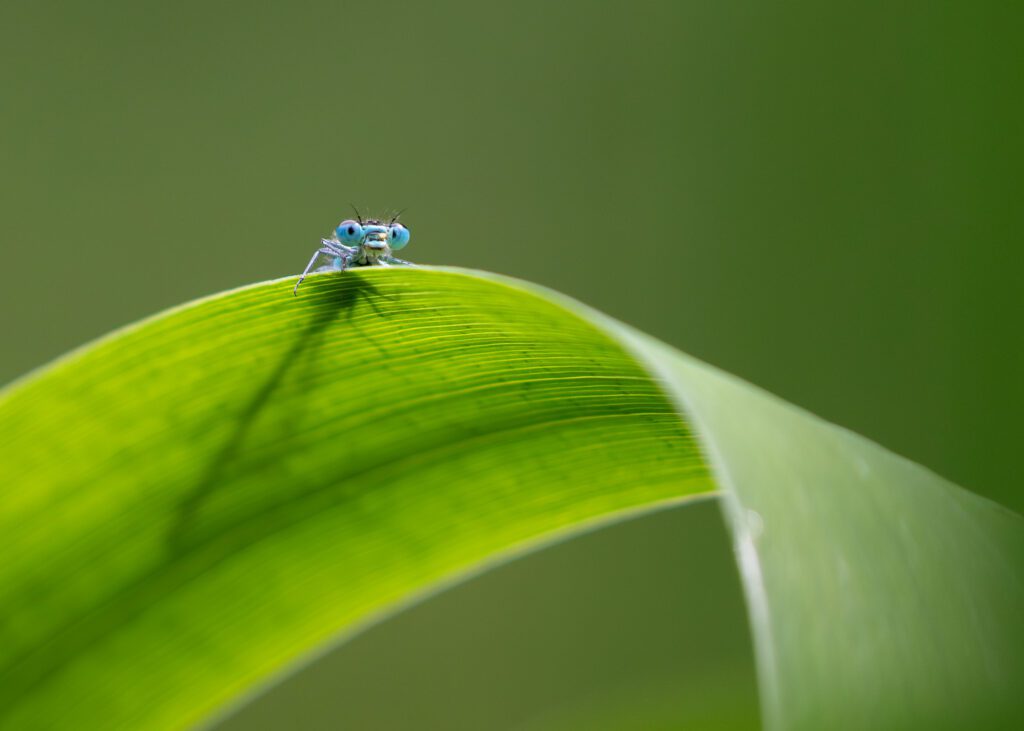
The final image in this damselfly series is one of my absolute favourite angles to photograph damselflies. If you are patient enough, you can often catch them overextending their perches. By positioning yourself at the right angle, you can manipulate their position to make it look as if they are cheekily peeping at you from behind their cover. I also love to capture the rest of their body in shadow on the underside of their perch. Next time you’re near a pond on a warm day, have a look for irises. No doubt you’ll find an abundance of damselflies to photograph.
Photographing Tadpoles, a Great Way to Test Your Technical Skills
Whilst photographing the abundance of damselflies, I noticed movement around the edges of the pond. I went in for a closer look and realised the movement was the result of one of the biggest clusters of tadpoles I had ever seen. They were asking to be photographed, but I knew it would be a challenge. Erratically moving dark subjects in dark water, which was highly reflective of light. I stood for a moment and observed, looking for common behaviours which would help me photograph them. That’s when I noticed a stick submerged near the edge of the pond. The tadpoles were fighting for the chance to rest on the stick. I fitted a circular polarising filter to my macro lens to reduce the reflections on the water and lined up a composition with the stick. Here’s what I came up with.
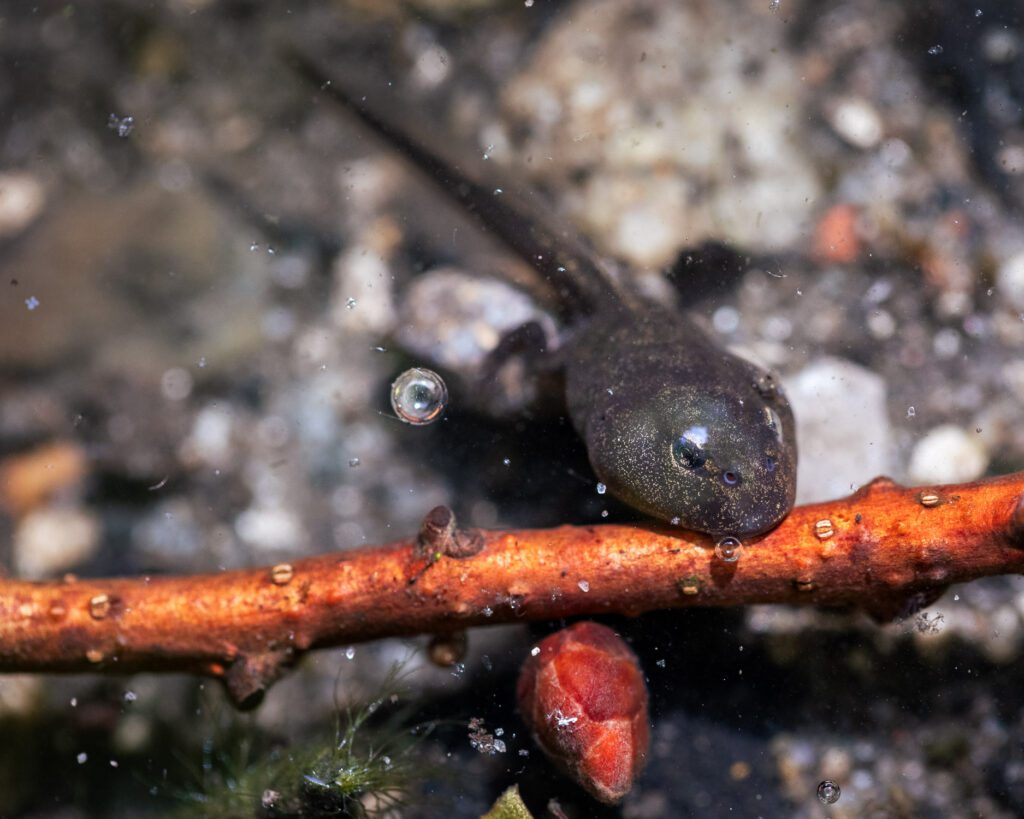
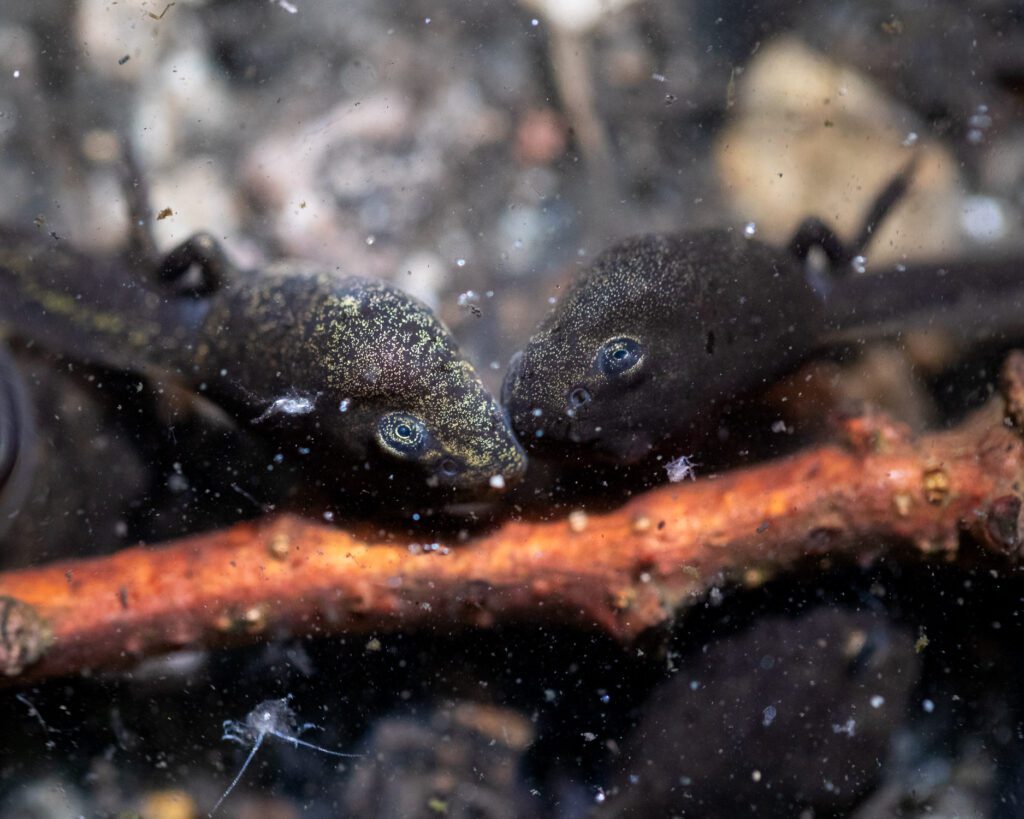
At times, there must have been hundreds of tadpoles fighting to rest on the stick, and so it was a patience game. I did try to photograph the large group of tadpoles, but it turned out pretty messy. Instead, I preferred these more intimate shots of a single tadpole and a couple having a moment together.
Summarising a Month of Spring Photography
Firstly, a massive thanks for sticking with me if you made it this far, and apologies that this turned out to be more story-based than technically driven. There was a lot to cover in this post, and adding technical information would have increased the length of this post tenfold. Instead, I’ll link to a couple of useful blog posts below. If you have any questions about camera settings or equipment, contact me, and I’ll be happy to help.
I set out to be more thoughtful and patient with my photography. Honestly, I’m over the moon with how the project went. It’s such an eye-opener that you don’t have to travel far to enjoy the peace and serenity of nature photography. It’s fair to say this is the spring that nature needed, especially after last year’s struggle.
I enjoyed looking beyond normality to capture photographs that told more of a story. Sometimes in photography, it pays to be patient and ignore the fear of missing out. It’s a trap we all fall into at some point, and this project has helped reinforce the importance of slowing down and enjoying the process.
I’m looking forward to seeing how the rest of the year pans out, fingers are crossed for a summer and autumn filled with plenty of photographic opportunities.
Useful Insights
Recognising that I haven’t been as in-depth with some of the more technical details throughout this post, below are a couple of previous blog posts which provide insights into macro photography.
Reflecting on the Future Direction of My Photography
The loss of my Dad was devastating, but I know he’d have been proud that I kept pushing on – he loved nature just as much as I do. I’ve never been one for competitions, but I now have fresh motivation. In memory of my dad, my plan for the future is to enter the Landscape Photographer of the Year (LPOTY) competition. Over the coming months, my focus will be firmly on building a strong portfolio of landscape photographs worthy of entering LPOTY. I’m in no rush, and the process will take as long as it takes. I’d rather ensure that the work I put forward is the very best of my ability. With that said, I’m looking forward to getting out in the field and capturing unique photographs that will stand out from the crowd. Follow my social media channels for progress updates and behind-the-scenes content as I work towards my goal.

